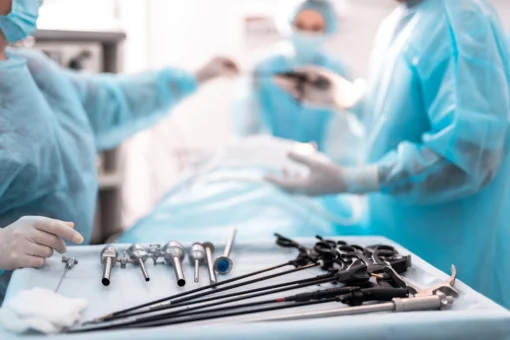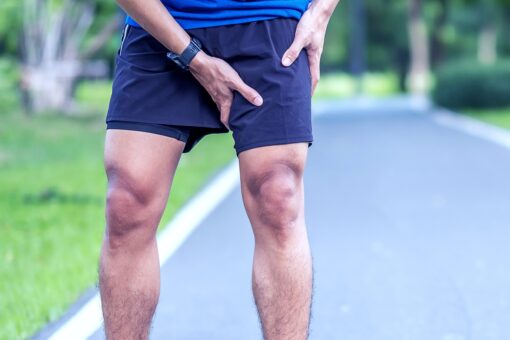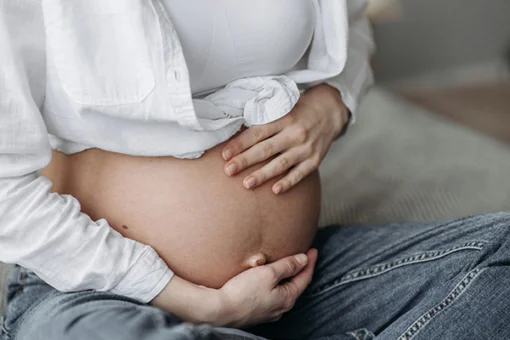Category: DE
Trocar hernias and incisional hernias
Trocar hernias and incisional hernias are late effects of abdominal and thoracic surgery. For successful treatment, it is important that these are surgically closed quickly before internal organs are trapped or the weak point can open up further.
Vice-abdominal surgery, especially abdominal wall surgery, always carries a certain risk. In around 10 to 20 % of cases, incisional hernias can occur at the sutures inside the abdomen in the months or years that follow. This is caused by sutures that have never healed properly. This is particularly common with sutures on the muscle envelope. Over time, these sutures can partially or even completely open and lead to weaknesses in the abdominal wall. In addition, the scar tissue does not have the same strength and elasticity as the regular tissue and there is a greater risk of a hernial orifice forming in these areas. The peritoneum and internal organs can then be pushed out of the abdominal cavity through the weak point in the abdominal wall. As these bridges occur in the area of scars from a previous operation, they are known as incisional hernias.
What causes incisional hernias?
The surgeon's incision technique, the suturing technique and the suture material used all have an influence on the development of incisional hernias. However, far more important factors come from the patient. A high proportion of fatty tissue makes it more difficult for the surgeon to suture the wounds accurately and being overweight increases the pressure in the abdominal cavity, so that incisional hernias develop more quickly. Diseases such as diabetes, wound healing disorders, collagen disorders or connective tissue metabolism disorders also have a negative effect on scar healing. Smoking even increases the risk of incisional hernias fourfold. In most cases, an incisional hernia does not pose a major risk to the patient, provided it is treated immediately. However, if organs and intestines become trapped in the hernia, this can lead to an intestinal obstruction, which can be life-threatening if not treated immediately.

Trocar hernias as a result of laparoscopic surgery
Incisional hernias used to occur much more frequently after major abdominal and thoracic surgery, as open surgery was usually performed. In the age of minimally invasive surgery, this has become much rarer. However, laparoscopic surgery can lead to so-called trocar hernias. Trocars are pin-shaped puncture instruments that are used to give the surgeon access to the body cavity. Surgical instruments or cameras can be inserted through the trocars, a type of access tunnel into the abdominal cavity or chest cavity. The risk of developing a trocar hernia is around 1% and is therefore much lower than that of an incisional hernia. However, even these small openings can ultimately cause scars in the tissue or weak points in the fascia. Tissue from the abdominal cavity can become trapped at these points and cause pain. Trocar hernias usually occur in the area of the navel or in the pit of the stomach, i.e. between the lower ribcage and the navel.
Intestinal obstruction as a result of an incisional hernia
Large scars are much more dangerous than trocar accesses, as parts of the intestine can also become trapped there, which in the worst case could lead to an intestinal obstruction. However, it is also possible that other internal organs are gradually pushed through the weak points. If the corrective operation is performed too late, it may even be difficult to close the abdomen correctly again. It is particularly important to recognize an incisional hernia at an early stage. If the patient has a corresponding protrusion in the area of a former surgical scar or pain at this point, they should have this clarified immediately by a specialist. Rapid action is essential, especially in the event of a possible bowel obstruction.
Examination and treatment procedure for incisional hernias
An ultrasound examination can be used to detect exactly where the scar has broken through and opened and how large the resulting gap is. In addition, a computer tomography may be necessary, during which the so-called Valsalva maneuver is performed. The patient presses gently during the examination so that the full extent of the hernia, i.e. the incisional hernia, becomes visible. How the operation is then performed in detail depends on the size of the incisional hernia and its contents, as well as the acute stage and, of course, the patient's previous operations. Whenever possible, visceral surgery attempts to correct the incisional hernia using minimally invasive techniques. In the case of large hernias, however, it is often necessary to open the old scar completely and attempt a complete reclosure. In the vast majority of cases, this also requires reinforcement by implanting a permanent or dissolvable plastic mesh. Following this operation, the hernia center usually advises a six-week rest period to relieve the abdominal muscles. Following the stay in the clinic, the muscles must be built up and strengthened in order to achieve lasting stability.
Do you possibly suffer from a trocar hernia or an incisional hernia? Or do you have problems with hernias? Contact the Hernia Center - we will provide you with competent and professional advice
Andere Beiträge
For successful treatment, it is important that these are quickly closed surgically before internal organs become trapped or the weak spot can open up further.
Men who play sports intensively or even practice a sport professionally complain about groin pain time and again.
Umbilical hernias occur more frequently during pregnancy. Many women ask themselves when they should have an operation.
Groin pain – What is the cause?
Groin pain often occurs in men who play sport intensively or are even involved in professional sport. The stabbing, burning pain in the groin usually occurs during physical exertion. It is important to find the causes of the pain before treatment, so that a targeted treatment program can then be created and carried out by a team of doctors and therapists.
The sports ridge
The term sports groin describes pain in the groin area, which often occurs after sporting activity, particularly in people who are active in sports. In most cases, the pain is not only acute, but often has a chronic course. Athlete's groin occurs more frequently in men due to anatomical differences. However, it can also occur in women. Before any attempt at treatment, the doctor should clarify exactly what the cause of the pain is so that it can be treated specifically. Without a clear diagnosis, it is difficult to prescribe the right treatment.
Possible causes of groin pain
The reasons for the pain in the groin area, which often radiates into the thigh, can be manifold. As a first step, the doctor should rule out acute injuries, such as a possible torn muscle fiber or a momentary overuse, such as occurs during a marathon. If pain in the groin area occurs repeatedly over a longer period of time during moderate sporting activity, further examinations should follow. Muscular problems in the groin or hip area can often be the cause of the pain. If overstretching occurs due to shortened muscles in the thigh and hip area, this repeatedly triggers pain during sporting activity. In this case, painful inflammation can also occur at the muscle attachment to the bone. The attachment of the ligament to the bone can also be irritated and cause painful symptoms.

Undiscovered inguinal hernia
Chronic groin pain can also be caused by small inguinal hernias that are not visible from the outside. A special case that can occur in men is the so-called spermatic cord lipoma. This is a tumor of fatty tissue that forms in the inguinal canal and causes similar symptoms to an inguinal hernia, but does not appear as such on the outside. Particularly when the adjacent muscle groups are strained or overstretched, a spermatic cord lipoma can lead to chronic irritation of the nerves, which again triggers pain that is very similar to that of an inguinal hernia.
Which examinations are necessary for an athlete's hernia?
In addition to the regular clinical examinations, ultrasound examinations are successfully used. Ultrasound can be used to detect possible inflammation in the area of the bones, skin and muscle attachments. The ultrasound monitor also shows whether there is a hernia or a spermatic cord lipoma. In some cases, GMC or CT examinations may also be necessary. However, these are only used as a supplement.
Possible treatment methods for an athlete's hernia
The chosen treatment method always depends on the diagnosis and the condition. Physiotherapeutic treatment often forms a good basis. In addition to manual treatment by a physiotherapist, targeted massages and stretching exercises also help. Acupuncture can also be used as a supplement. If none of this leads to success, infiltration, i.e. an injection treatment, for example with autologous blood (ACP / PHP), can be carried out in the case of inflammation of the muscles or the inguinal ligament. This often brings significant relief. Infiltration with cortisone can also bring rapid improvement. However, it is controversial and carries the risk of bilateral tears in the tendon or muscle area. If none of these procedures can improve the condition, surgery may have to be considered.
Procedure for spermatic cord lipomas or small inguinal hernias
Spermatic cord lipomas or small inguinal hernias are usually treated using the so-called minimal repair technique due to their small size. Only a small incision is made and the gap in the inguinal hernia can be closed without the implantation of foreign materials. Existing spermatic cord lipomas are removed and after a short recovery phase, targeted training therapy can be carried out.
Individual treatment options for athletes' groin
Another surgical option for treating the sportsman's groin is to detach and reposition individual muscle or tendon bundles. The offset attachment points significantly reduce the tension and relieve the groin. Since such cases are individual problems, it is always necessary to review the results of the examination together with the patient and examine the various treatment methods.
Sports breaks for athletes' groin
The length of the break from sport or training usually depends on the type of treatment. The aim is for the patient to be able to play sport again without any restrictions or pain. The aim is to avoid the burden of chronic pain and the risk of long-term damage or long-term consequences.
Do you regularly suffer from pain in the groin area? Contact the Hernia Center for a prompt examination appointment.
Andere Beiträge
For successful treatment, it is important that these are quickly closed surgically before internal organs become trapped or the weak spot can open up further.
Men who play sports intensively or even practice a sport professionally complain about groin pain time and again.
Umbilical hernias occur more frequently during pregnancy. Many women ask themselves when they should have an operation.
Umbilical hernia during pregnancy
Umbilical hernias occur more frequently during pregnancy. Many women ask themselves when they should have this surgery.
Around 25% of women of childbearing age have an umbilical hernia - it often goes unnoticed. Pregnancy, in which the pressure on the abdominal wall increases from the second trimester onwards, often leads to a protrusion of the navel. The abdominal wall becomes unstable due to the pregnancy-related softening of the abdominal muscles. This promotes the formation of hernias. As the belly button is a general weak point in the abdominal wall, this area is predestined for a hernia, especially during pregnancy or if you are very overweight. Additional risk factors are the increasing number of pregnancies, abdominal dropsy, significant weight loss or weak connective tissue.
Symptoms of an umbilical hernia
An umbilical hernia is indicated by a bulge in the navel, which is usually between 1 cm and 5 cm in size. Particularly in the second half of pregnancy, the navel can protrude outwards. In general, the hernia should not cause any pain. Slight pain may occur when coughing or lifting heavy loads. Small umbilical hernias that have formed during pregnancy can often disappear on their own after the pregnancy. Postnatal gymnastics and training the abdominal muscles have a beneficial effect.
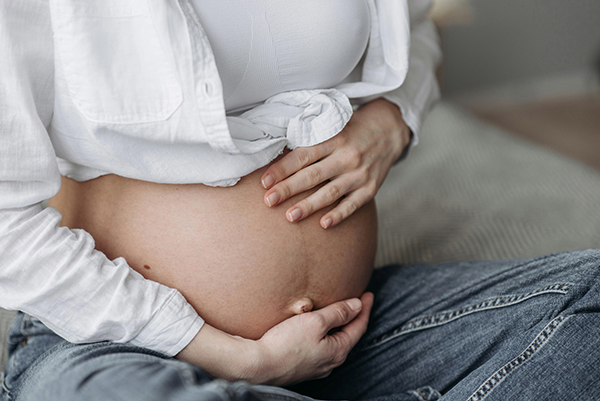
When is an umbilical hernia an emergency?
If there is intestinal tissue in the hernia sac of the hernia, this is an emergency, as parts of the intestine are then cut off from the blood supply and are no longer properly supplied with blood. Colic-like pain often occurs and the abdomen is sensitive to pressure. Sometimes the area around the navel becomes bluish in color. The patient may also suffer from fever, nausea and vomiting. In this case, you should call us immediately or go to a hospital emergency room.
When does an umbilical hernia in women need to be operated on?
Many women affected by an umbilical hernia ask themselves whether they should have it operated on and when the right time is. Should it be done before a planned pregnancy? Or is it better to wait until after the current pregnancy? Your doctor can often determine whether or not you have an umbilical hernia by palpating your abdomen. Sometimes the ultrasound device is also used for diagnosis. The doctor checks whether the hernia can be pushed back. Statistics show that in 56% to 73% of women who had an umbilical hernia operated on before pregnancy, a new hernia (recurrence) occurs in the next 10 years. For this reason, doctors recommend waiting until after family planning is complete before having an operation. During pregnancy, surgery is generally only performed in an emergency, i.e. if the hernia is causing pain or if intestinal tissue has become trapped in the hernia sac. Such an operation can usually be performed in the day clinic and, if desired, under local anesthesia. In most cases, the hernia gap is closed with a simple suture, as the use of a plastic mesh during pregnancy could lead to more severe abdominal wall pain.
After a pregnancy, you should wait at least 6 to 12 months before having the hernia operated on. During this time, the hernia and any rectus diastasis can heal on their own. Once the last planned pregnancy has been completed, the hernia only needs to be operated on if it is troublesome, causes pain or becomes larger. Otherwise, you can wait as long as you like before having an operation. If a rectus diastasis has developed during previous pregnancies that cannot be reduced by training alone, this can be repaired at the same time as the umbilical hernia is surgically repaired.
Andere Beiträge
For successful treatment, it is important that these are quickly closed surgically before internal organs become trapped or the weak spot can open up further.
Men who play sports intensively or even practice a sport professionally complain about groin pain time and again.
Umbilical hernias occur more frequently during pregnancy. Many women ask themselves when they should have an operation.
Inguinal hernia in women – What are the symptoms?
Inguinal hernias occur less frequently among women than men. Only in 10% of all cases does it affect a woman. In these cases, surgery is usually advised, as a femoral hernia can be hidden behind it, which causes complications in 30% of cases.
Inguinal hernias affecting women are usually operated on as soon as possible. Although they occur much less frequently, emergency operations are four times more common among women. Why does an inguinal hernia occur? The inguinal canal connects the inner abdominal cavity with the groin area. Its task is to guide blood and lymph vessels, nerves and the ligament to the genitals. It is a natural weak point in the abdominal wall and is therefore more susceptible to hernias. In the event of a hernia, the peritoneum, fatty tissue or intestines bulge through this gap in the abdominal wall. Weak connective tissue or weak abdominal muscles, as well as obesity or smoking, can further promote inguinal hernias.
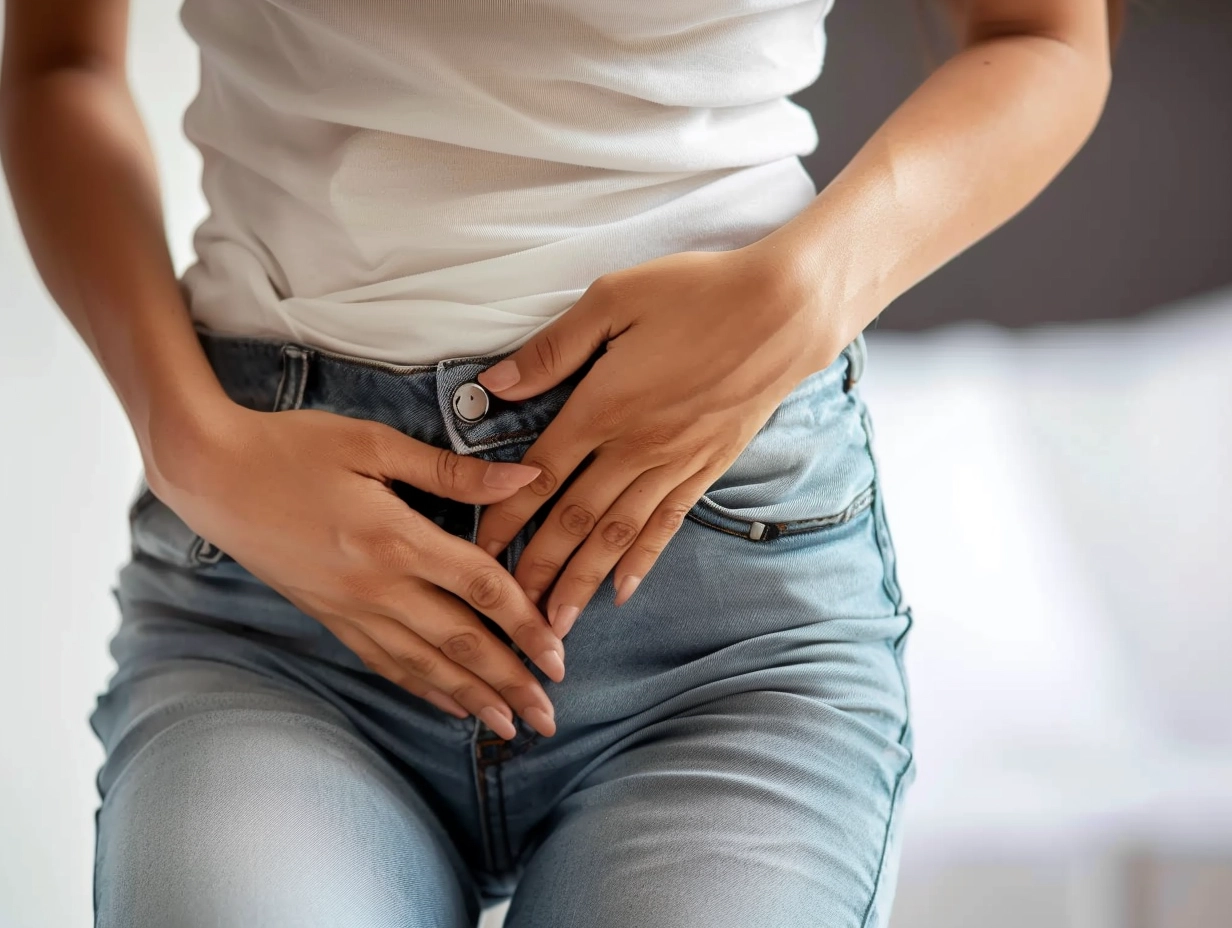
Inguinal hernia symptoms in a woman
A typical symptom of an inguinal hernia is swelling in the groin area. However, this can also occur in the genital area or on the labia. If the hernial sac is turned outwards, this is called a direct inguinal hernia. It is also possible for the hernia sac to protrude towards the inside of the body, which is called an indirect inguinal hernia. As with a femoral hernia, no protrusion is then visible, but pain or a pulling sensation in the groin area can still be felt. It usually feels more like an unpleasant pressure or foreign body sensation. If a protrusion is visible, it can often be pushed back for a short time. The pain is less noticeable when lying down or at rest. If you lift something heavy, stand for a long time, cough or sneeze or push during a bowel movement, the pain increases.
Why are inguinal hernias in women almost always operated on?
Even if the patient has no symptoms, surgery is usually advised. Complications are more common in women and it often becomes apparent during the operation that it is a femoral hernia (fermoral hernia) and not an inguinal hernia at all. Femoral hernias are not always easy to diagnose, but can cause serious complications. In a femoral hernia, the hernial sac underneath the inguinal ligament protrudes towards the thigh. This is not always immediately visible. In around 30% of cases, the so-called fermoral hernia becomes trapped, making immediate surgery necessary. Statistically, women are affected by fermoral hernias much more frequently than men, which is why doctors do not recommend waiting for surgical treatment in women.
Inguinal hernias during pregnancy
An exception is a prolapse during pregnancy. This is rare. The probability of an inguinal hernia occurring during pregnancy is only 0.12%. In this case, however, the doctor may recommend waiting until after the birth to operate. A quick operation is only necessary if an incarceration occurs and complications are imminent. During pregnancy, the round ligament of the uterus (ligamentum rotundum), which passes through the inguinal canal, may also show enlarged vessels, similar to a varicose vein. This can initially lead to the suspicion of an inguinal hernia.
Inguinal hernia surgery in women
In general, there is a greater risk of a hernia recurring in women (recurrence). If a minimally invasive technique (TEP or TAPP) with mesh insertion is used to treat the hernia in women, the risk of recurrence is lower than with open treatment using the Lichtenstein procedure. Regardless of whether it is an inguinal hernia or a femoral hernia - both can be treated in a laparoscopic procedure. For very small femoral hernias in women, biodegradable meshes can be used, which dissolve over time. The mesh insertion also allows the patient to take weight more quickly after the operation than if the treatment is carried out purely by suturing the adjacent connective tissue. With TAPP (transabdominal preperitoneal plasty), the abdominal wall must be cut through for the operation, whereas with TEP (total extraperitoneal plasty), the operation is performed within the abdominal wall. The surgeon therefore goes less deeply into the body with the instruments for TEP than for TAPP. Nevertheless, the recovery times after the operation, recurrences, side effects and pain are somewhat the same for both procedures.
Andere Beiträge
For successful treatment, it is important that these are quickly closed surgically before internal organs become trapped or the weak spot can open up further.
Men who play sports intensively or even practice a sport professionally complain about groin pain time and again.
Umbilical hernias occur more frequently during pregnancy. Many women ask themselves when they should have an operation.
Hiatal hernia
A hiatal hernia can be indicated by difficulty swallowing or heartburn. How this is treated is best decided by a gastrointestinal specialist and an experienced surgeon working as a team.
Symptoms of a hiatal hernia
Do you suffer from acid regurgitation, shortness of breath after eating or an unclear feeling of pressure in the abdominal area? This may be caused by a hiatal hernia or hiatal hernia. This is often accompanied by difficulty swallowing, which occurs more frequently with dry foods such as bread or meat. The patient has to drink more while eating in order to be able to swallow the food properly. The saliva can become foamy or viscous and the food can come up again. In the worst cases, pain occurs in the chest area, which can radiate to the back.
What exactly happens with a hiatal hernia?
The diaphragm acts as a partition between the chest and abdominal cavities. The oesophagus transports our food into the stomach and runs vertically through the diaphragm. The opening in the diaphragm is enlarged in the event of a hiatal hernia, so that parts of the stomach can temporarily or even permanently push through the gap towards the chest. The worst form is the so-called upside-down stomach, in which the entire stomach moves from the abdominal cavity into the chest cavity.
Was passiert genau bei einem Zwerchfellbruch?
The diaphragm has the function of a partition between the chest and the abdominal cavity. The oesophagus transports our food into the stomach and runs vertically through the diaphragm. The opening in the diaphragm is enlarged in a hiatal hernia, so that parts of the stomach can temporarily or even permanently push through the gap towards the chest. The most serious case is the so-called upside-down stomach, in which the entire stomach moves from the abdomen to the chest.

Causes of a hiatal hernia
The cause of a hiatal hernia or hiatal hernia can be a chronic weakness of the connective tissue or fluctuations in weight, in particular heavy weight gain. Chronic connective tissue diseases such as rheumatism, chronic coughing or pregnancy can also trigger a hiatal hernia. Hiatal hernias occur more frequently in old age. However, they can also occur in young patients. It is usually a gastrointestinal specialist who makes the diagnosis during a gastroscopy. He can examine the hernia with a camera and assess whether the backflow of acid from the stomach into the oesophagus has led to a chronic change. If this is left untreated, in the worst-case scenario it can lead to changes in the cells of the oesophagus and cancer over many years.
Consultation with a surgeon
The exact size of the hernia cannot usually be estimated with certainty by the gastrointestinal specialist, so that a computer tomography scan with a so-called Valsalva maneuver is often required as part of a corresponding examination by the surgeon to plan the further procedure. For this, the patient is X-rayed in a narrow tube and must close their nose and mouth and press hard during the examination. This simulates the excess pressure in the abdomen and allows the surgeon to recognize the exact extent of the hernia. Depending on the symptoms and size of the hernia, an attempt is first made to alleviate the discomfort caused by the retreating acid from the stomach with medication. The acid production is blocked by medication, which reduces the irritation of the mucous membrane. If this is of little use because intolerable side effects occur or the symptoms worsen, a surgical solution must be considered.
Surgical treatment of a hiatal hernia
The aim of an operation is to close the oversized gap in the diaphragm. This is usually carried out in a minimally invasive manner using laparoscopic surgery (laparoscopy) or with the aid of a surgical robot. The parts of the stomach that have slipped into the chest are moved back into the abdominal cavity and the gap in the diaphragm is closed using various techniques. It is preferable to aim for a biological closure in which the muscle loops in the diaphragm are reunited, thus achieving natural stability. If necessary, this situation can also be temporarily secured with a dissolvable plastic mesh, which does not cause any permanent problems. Sometimes it is also necessary to form a sleeve from the stomach itself, which is placed around the stomach to prevent it from moving back into the chest.
Possible complications
There are various surgical methods, all of which have their advantages and disadvantages. After the operation, slight swelling in this area and slight disturbances in food intake are to be expected, but these should subside quickly. In the best case scenario, all the symptoms from before the operation will be resolved quickly. However, particularly in the case of large fractures and necessary operations using a cuff technique, there are also recurrences. This means that another fracture can occur, which may have to be operated on again. It is also possible that the narrowing is too severe, resulting in permanent problems with food intake and swallowing, which also have to be corrected by surgery. In this respect, surgical intervention must be carefully considered. Good advice from an experienced surgeon in consultation with a gastrointestinal specialist is of great importance. The advantages and disadvantages should be discussed in detail with the patient..
Do you have symptoms that indicate a hiatal hernia? Make an appointment for a consultation at the Hernia Center Switzerland.
Andere Beiträge
For successful treatment, it is important that these are quickly closed surgically before internal organs become trapped or the weak spot can open up further.
Men who play sports intensively or even practice a sport professionally complain about groin pain time and again.
Umbilical hernias occur more frequently during pregnancy. Many women ask themselves when they should have an operation.

